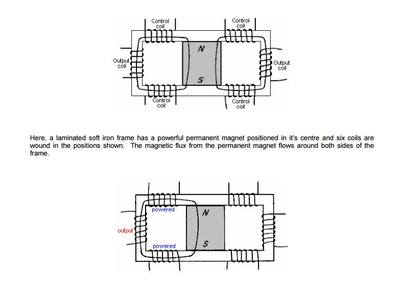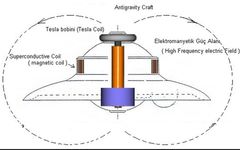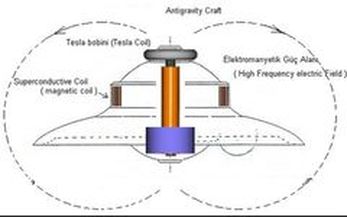Tesla didn't say that Earth is a vast reservoir of negative charge .. he said the Earth is a vast reservoir of negative electricity. The Earth's surface charge is a positive charge. Tesla was smart enough to realize this, that the negative pole of a battery grounded and formed a circuit to the positive charge of the Earth surface (ground). .... What he CLAIMED is that Earth is a vast reservoir of negative energy. Negative electricity is MUCH DIFFERENT than the negative electrical charge!
I'm borrowing a couple of images here, to illustrate how well known this technology is to one who does just a little bit of research and follows the synchronicities (trail of bread crumbs; one step leads to the next, etc), guided by their own inquisitive mind.
Here we see the MEG, and the Tesla coil, used in antigravity applications, just like how this website describes on the various pages like the Outer Ring page, and the Construction Blog page.
I'm including this article on this page because it relates to Tesla, who in conjunction with Townsend Brown are considered the fathers of electrogravitation.
Here is the direct link to the MEG via the Tom Bearden website: http://www.cheniere.org/megstatus.htm
Also, Tom Bearden's 69 page "MEG paper" can be found on this link: http://jnaudin.free.fr/meg/meg.htm
Some of these types of systems used with an antenna and a ground can become self-oscillating for a while, after being disconnected from its power supply. In fact, several things will do that. The MEG made by my mentor did that, and Marko Rodin's systems have demonstrated a spinning magnet continuing to spin inside one of his toroid-shaped coils for a few minutes after the power has been turned off.
The image on the right is the Haunebu II ... It uses a Tesla coil system with electromagnets around the perimeter, similar to the OTC-X1 geometry, but providing vacuum lift up through the coil (similar to what is seen on the below articles on this page).
The Tesla coil will either draw energy up, or down, depending upon the polarity of a secondary actuating winding around the tall coil, in DC configuration (also shown on the Tesla Engineering Physics page). Superconductivity is demonstrated by using scalar negative energy, longitudinal waves able to travel at around 220,000 miles per second according to Eric Dollard and his team of HAM radio enthusiasts who have measured this speed of parallel and longitudinal waves.
The Tesla coil is the "magnet in the middle" similar to the MEG-like device on the left image, but it is acting as a static-magnet, however with a moving current.
Concerning a static magnet applied to building a Tesla system like mine: It's weird, the secret isn't in the math, but in the ability to physically feel the sensation of the light electric subtle wispy energy. When you start to feel it, then you can build upon it so that it's so big, anyone can feel it. Then you can bring it to life with a static magnetic current. A static magnet is the only way to describe it. It is a moving current, but you can set it in motion like how small fast gears turns a larger slower wheel. But when that large wheel starts to turn, there's tremendous force behind it.
A static magnet is a magnetic field combined with an electrostatic charge, but ....... don't confuse the term "static" with a meaning of "being in one place; immovable." Static charges is something you have to physical feel to understand. The best example is one of those plasma balls -- the glass globe with the plasma emanating from the center of a small sphere, seen in movies and at gizmo shops. When you put your hand on the glass outer sphere, you feel tingly electrical energy. That is static. A term Tesla used to describe as being "in the air." However as plasma is also produced in a near vacuum, static also exists in a near vacuum, convenient for usage of charging a spacecraft hull in a vacuum.
A static magnet however is softer than that, and sometimes it feels more like water than electricity, although there is a distinct electrical feel to it.
In the image on the right, you can see how lift is generated, similar to the impeller on the LAU-X4. It is also similar to the central accumulator of the OTC-X1. I wanted to share these relations to better illustrate the simple principles discussed in this website.
Also, similar to the original concept of the vertical cones approach, using a Tesla toroid on top, energizing the space of the cones inductively, what is happening in the image on the right is the outer hull being charged electrically, and the field shaped by the electromagnets (or resonance coils). Either resonance coils or electromagnets with a little thickness to them is how the OTC-X1 works. A spark collapse can still occur, although I am leaning toward electromagnets, because that is the common denominator with coils in the outside perimeter position.
You'll notice the similarities with Townsend Brown's little 3 foot disks in the Haunebu III. As seen on the Construction page (not the blog), that a dielectric and magnetic layered hull plating also works, which was also used by Tesla. The style of construction required to build "Townsend Brown / Tesla" style hull plating is found in the Townsend Brown section on the Construction page, with a link to tests achieved: https://arxiv.org/pdf/1611.02576.pdf
More about Townsend Brown can be seen at the bottom of the Updates and Design Improvements page. It's funny that "stressing the di-electric" easily applies to a Tesla coil as the di-electric.
Although I have never seen any flying Tesla coil, as I've said several times, the aeroframe is a necessary component, along with field coils and a central core. The bottom of the Tesla coil in the image on the right is a layered capacitor stack. That works similar to a secondary winding, but the charge is spread out along the plates, yet translates laterally and inductively to the vertical coil.
Addendum:
Things to note. The Tesla coil touches the airframe so you have the Tesla toroid on top and the whole thing sits inside a similar hollow metal scalar shape - the hull. Its known that the long vertical coil radiates longitudinal waves which is responsible for wireless transmission of power to say, light a lightbulb in a bowl of water 10 feet away. The scalar field is a superconductive field.
A spark gap has to be employed to change the nature of the energy in a Tesla coil. In the MEG, there doesn't need to be a spark gap.
This has its basis in the spark collapse of a collapsing electromagnetic field. Without the spark gap in the Tesla system, it does not produce scalar waves. The spark gap changes the nature of the energy from electromagnetic to magneto-electrostatic. This is another example of negative energy in use.
Notice the electrical geometry of the airframe shape in a sphere, containing the Tesla coil and capacitor cage on the bottom.
The "wings" are an important dynamic to shape the energy flowing over the hull.
Also, the outer coils connect to the airframe just like the output coils act in the MEG.
Mass is reduced with the outer electromagnets employed. The overall geometry of buildup of EM and collapse mimicks this structure: the outer electromagnetic field collapses toward the center superconductively and longitudinally, resonating with the central core.
Since mass is electromagnetic, this resonance action creates a negative mass field, or a negative energy field.
--------- PART II ---------------
This is the next step after the Tesla Ley-line. It's easy enough to do, basically get a mini Tesla tower to fly in a little disk. Powered from the spark derived from electromagnetic collapse. That is a specific type of energy. Your dealing with a collapse of electromagnetic space -- the volume of the electromagnetic field (AKA AMPERAGE), and at very high volts, whereas many people have videoed themselves physically touching this energy at the end of a copper or steel rod they hold in their fingers.
Its not the same energy that comes out of a Van der Graaff generator, which uses the build up of charge.
This stuff takes time to build, but a small little test disk to test antigravity and magnetostatic lift is something I can do myself on a limited budget. This is something ANYONE can do, just as long as they derive their power from a "spark collapse."
Two ways to tune frequency is to use an air variable capacitor, and a Tesla transformer (like an old radio coil tuner, with a bar magnet inside the coil for higher frequency resonance). It's all based on basic radio; old radio kits used to be for ages 12 and up.
Go pick you up a decent store-bought induction coil and hook up a 6 volt lantern battery to it. That'll be good enough to get you a rapid sparky discharge at a workable frequency. Then tie in a couple of bare wires (like some 4 inch pieces of a wire clothes hangar) to the output terminals so the spark can arc between them. Connect your coil start and finish ends to your output terminals (positive and negative), or to the ends of the bare wires. ...
It's a simple matter to install air variable capacitors and a tuning coil (might have to make your own, like a good 2 foot tuning coil with a bunch of cylinder-shaped magnets stuffed inside the coil). Connect your output after that mess, directly to the little test craft.
It's so simple, that all you have to tell someone is "magnetostatic lift," and they'd be like, oh! like a charged feather hovering. ... if you tell people about mass reduction, and gravity cancellation, they'd think yer crazy
... I should note that the capacitor layer is using di-electric plates with thin magnet plates between them, as per the tests of the Townsend Brown effect in a vacuum, explained on the Construction page (not the blog page).
Further update; vacuum chamber testing:
Kinda like an electrostatic lifter but different. Put a digital clock inside see if it'll warp time ... that'll check to see if mass is being reduced.
Test it in a vacuum chamber to see if it works like the EM drive. This thing requires an airframe tho. The EM drive didn't. The EM drive didn't charge the outside of the hull but the inside. Although this should demonstrate mass reduction, whereas the EM drive didn't.
Could make this sucker air tight or add a double hull (another hull layer with air space in between the hulls so it has some air to work with in a vacuum). Give it a hollow space for air to flow around the hull then return up thru a central hollow pipe thru the capacitors and coil and out the top.
The EM drive worked in a vacuum chamber using microwave RF frequency. I think Tesla energy is a lot safer than microwaves.
It can just be treated like an engine, without having to worry about pilots. Put the top Tesla donut inside the aeroframe.
I give it two thumbs up for ease of construction (no moving parts), and viability.



 RSS Feed
RSS Feed